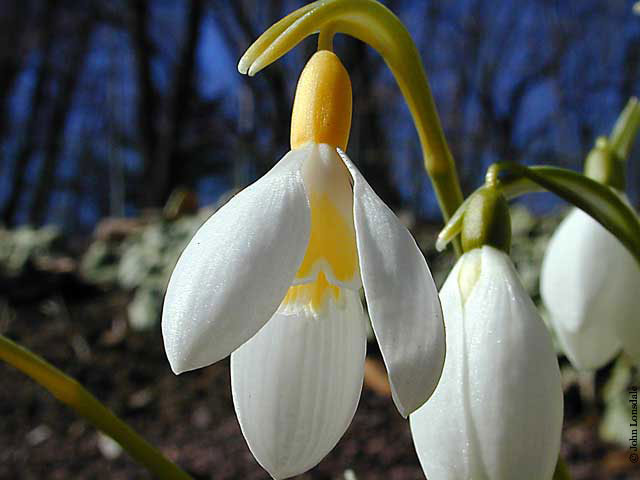Also known as snowdrop, galanthus is a plant that flowers about the same time as crocus (March through May, depending on where you live). As the name implies, it is hardy in the cold climates, which is good news for our New England neighbors and other northern gardeners. Galanthus will also do well in the southern climates where it flowers a little earlier in the spring.
Snowdrops have petite, lightly scented white flowers, suspended from a 6-8 inch tall stem. Each flower consists of three petals, which droop down and often have specks of green on the tips. There are three more white petals on the inside, also dotted in green, making it a real gem to look at in the spring garden.
Galanthus is native to western Europe and comes from the Greek words meaning flower and milk. There are more than 15 species of snowdrops in cultivation. To give you fair warning, every part of the plant is toxic, which keeps the squirrels away. However, you should be careful when handling the bulbs, which can cause skin irritation.
When to plant:

Plant galanthus bulbs in the fall after the ground has cooled, which means late September to early October in the northern states (zones 3-5), and into November in the southern states (zones 6-8).
Where to plant:
Plant galanthus in full sun or light shade and in well drained, preferably sandy loam soil. Snowdrops can be naturalized in a lawn or grown as part of a collection of spring flowering bulbs in a garden bed.
Planting depth:
Most bulbs should be planted 2-3 times as deep as they are tall. For galanthus, that will mean planting them 3-4 inches deep. The tip of the bulb should be pointed upward.
Spacing:
Space galanthus about 6-8 inches apart.

How to plant galanthus bulbs:
Let’s face it, most bulb planting methods have us spending a lot of time bending over or on our knees. The ProPlugger 5-IN-1 Planting Tool allows you to do most of the hard work of digging your bulb planting holes from a standing position.
To pull plugs, slide the 2″ or 4″ metal depth ring onto the bottom of the main tube to set the desired depth of the planting hole. Or to dig a 6″ deep hole, no depth ring is needed.
(Step, Twist and Pour) Step down on the foot pegs until the depth ring bottoms out against the ground. Give the 5-IN-1 a slight twist to break the soil plug free and pull straight up on the handlebars. To empty the plugs, simply turn the plugger upside down and pour the plugs out of the top of the tube.
The soil gets stored inside the tool as you work, enabling you to dig over a dozen planting holes, one right after another. Place the bulb in the planting hole, pointed tip facing upward. Fill in the hole with the soil you removed with the 5-IN-1. Firm the soil over the bulb with your foot.
Feeding and fertilizing:
When the leaf tips begin to poke out of the ground, apply a 5-10-10 fertilizer. About the time of flowering, top dress with a 0-0-10 or 0-0-50 fertilizer. Fertilize in the spring of each year with a 5-10-10 fertilizer or all purpose fertilizer used for feeding flowers. Mulching around the plants with aged compost or well rotted manure will achieve the same effect as a light feeding of fertilizer.
Popular varieties of galanthus:
Galanthus nivalis Flore Pleno,Galanthus The Last Snow Mix, Galanthus Sam Arnott, Galanthus Hippolyta.
Hardiness zone:
Galanthus are hardy in zones 3-6; however, this varies by variety, so always check to make sure the galanthus you purchase are hardy for your area (click here to find your hardiness zone by zip code).
Disease and pest problems:
Galanthus are generally disease and pest free, providing you’ve purchased firm, quality bulbs.
Neil Moran is a horticulturist and author of three books on gardening. He is also the creator and author of the garden blog North Country Gardening.
Be sure to check out the helpful information on our website, including other uses for the ProPlugger including:

